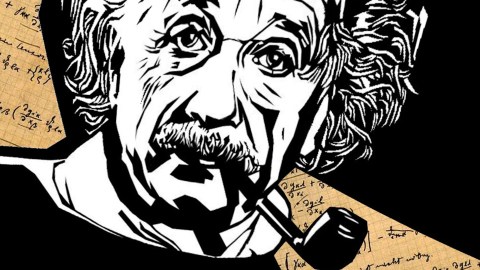How Einstein illuminates the art of modern leadership

MUDr. Jiří Srna / CC BY-SA 4.0 / Wikimedia Commons
- Modern leaders understand that when they focus on helping others achieve success, they are also more successful and more trusted.
- The most effective leadership is about showing vulnerability and making connections.
- The art of modern leadership is understanding that both head and heart are important in different ways.
Until only very recently, we have been taught that our personal and professional worlds should be kept separate. It was only in 2017 that Professor Robert Kelly was famously interrupted by his two children and wife during a live interview with the BBC from his home. The intersection of our private lives on the public stage was still a novelty at the time and the footage went viral. Kelly assumed it was the end of his career. ‘I thought I’d blown it in front of the whole world.’
Fast forward three years to the COVID-19 pandemic and interruptions of this kind became a daily occurrence. It is now unthinkable to expect anyone could worry about the impact of such an event on their careers.
Unrealistic expectations of leaders to have a professional persona, quite separate from how they may conduct themselves privately, have pervaded our working lives for centuries. This way of thinking about leaders comes at the cost of leaders being able to successfully integrate their leadership across all contexts in which they influence and impact others.
Modern leaders are no longer the heroic leaders of the past like King Adolphus, Jack Welch and so many others. They are no longer managers focusing on themselves, the task at hand and a static environment. Leaders are not expected to have all the answers or solutions. Modern leaders serve the people they lead and focus on how to coach others to be successful, rather than being driven by their individual success. Modern leaders understand that when they focus on helping others achieve success, they too are more successful, more trusted and more effective.
Where once managers may have delegated people-related tasks to specialists in human resources teams, modern leaders understand that to be a successful leader they need to consider themselves a people leader, or what executive coach Hortense le Gentil called in the Harvard Business Review, ‘human leaders’. Le Gentil suggests the most effective leadership, at all levels, is about ‘being human, showing vulnerability, connecting with people, and being able to unleash their potential’.

Modern leaders embrace the idea that they can integrate the leader they are at work, with the leaders they are outside of work. They understand empathy or curiosity they may show their children at home draws on the same skills and qualities leaders in the workplace need as well. Modern leaders appreciate the self-awareness they have of their impact on others in meetings and in workshops with colleagues, is the same self-awareness that will be beneficial as a volunteer in the community or when engaging with family and friends.
Modern leaders are required to lead in fluid, rapidly changing environments that require us to adapt to new, often radically uncertain, circumstances. The teams we lead may be in the same building or they may be people we never meet in person. The challenges for leaders today are immense, which is why modern leaders, who can lead with their head and their heart, are the leaders we need for modern times.
Einstein reportedly observed that, “Not everything that can be counted counts and not everything that counts can be counted.” This is an apt way to think about head and heart leaders in practice.
‘When you have the head and heart integrated, people can feel it. They may not be able to define it, but they want it in their leaders,’ says corporate leader Miriam Silva.
Einstein reportedly observed that, ‘Not everything that can be counted counts and not everything that counts can be counted.’ This is an apt way to think about head and heart leaders in practice. Much of it comes down to intuition.
When I spoke with the CEO of BHP, Mike Henry, we both began to laugh after I asked Mike whether he considered himself to be more a head-based leader or a heart-based leader. He immediately started to rank the eight head and heart leadership attributes in order of weighting. I joked with him that this is very much something a head-based leader would do.
But, Mike Henry says that as he has matured in his career and in age as a leader, he has felt freer to be able to lead with his heart. Early in his career he prioritized looking at logic and data without necessarily incorporating empathy. Now, he believes incorporating empathy into his leadership and the decisions he makes is essential. Empathy is, for Mike, the most important aspect of his leadership and, in particular, the power of inclusion of other perspectives. ‘Being willing to listen to the perspectives of others means you can create something way bigger than you ever could through logic,’ says Mike. ‘There is a much deeper appreciation, and understanding, through leveraging and drawing on the perspectives of others.’
“Being willing to listen to the perspectives of others means you can create something way bigger than you ever could through logic.”
Mike Henry, CEO BHP
The art of modern leadership for Mike is understanding that sometimes it is not about the logically correct answer a spreadsheet may provide, since that may not offer a positive long-term solution. ‘Being willing to understand the needs of, and views of, a larger population and tapping into that can unlock much better performance in the near term but can also build a level of energy and momentum that will give rise to bigger and better things you can’t even envision today,’ says Mike.
Union leader Sally McManus gave me a definitive answer to the same question. ‘I think I am 60 per cent head and 40 percent heart,’ says Sally. ‘I am more inclined to the head, but I have worked to get better at the heart. I know what my blind spots are.’
Ask yourself: Do you consider yourself to be more of a head-based leader or a heart-based leader? There is no correct answer to this question. You might answer it precisely as Mike and Sally have done. Or you might remember a meeting this morning when you were more head-based but a conversation last week that required you to bring all your heart-based skills to the fore.
The art of modern leadership is understanding both head and heart are important at different times and in different ways. Knowing what is needed, and when, is key. This will take all your skills of intuition to learn and develop over time. Our experience and maturity as leaders will mean our confidence and ability to integrate our leadership to lead with the head and the heart will change as we expand our experiences.
If we want to influence the modern leaders of tomorrow, we need to role model modern leadership to all children today. It is teachers who lead and teach with their head and heart who hold the most powerful influence over the adults of the future. Research tells us that children as young as five years old already possess concepts of what it means to be a leader, and by the age of eight they have developed ideas of what it means to be an effective leader. There is no doubt early relationships and experiences with leaders like teachers are fundamental for the establishment and development of leadership stereotypes in children.
It is modern leaders who will most effectively lead our countries, run our businesses, make new discoveries, raise young families. Modern leaders can lead in a way to truly make a difference in the world, in the community and to those you love. You leave a legacy as a leader in every action you take, every decision you make and every behavior you demonstrate. What legacy do you plan to leave today?





